Land In A Contaminated State
Under “land in a contaminated state“, companies can receive relief for the expenditure they incurred when decontaminating land that was acquired with a contaminate in, on or under it.
Qualifying Conditions
The land must be in the UK, owned by the claimant and the contamination has to:
- Be causing or have the serious possibility of causing relevant harm to humans, property or the environment
The contamination also has to either be:
- The result of previous industrial activity e.g. mining, quarrying, manufacturing, construction, service supply, etc.
- This includes previous industrial sites, but also land that is contaminated with a product that was the result of industrial activity, such as asbestos.
- Japanese Knotweed (which develops before or after acquisition)
- The presence of radon or arsenic
Qualifying Expenditure
Qualifying expenditure includes the employees, professional fees, subcontractors and material costs for:
- Establishing the level of contamination and the cost of removing it, e.g. surveying, testing or professional advice (This investigation stage is essential and businesses can only claim for land remediation relief if they complete it)
- Removing contaminates such as asbestos or for the chemicals used to treat of harmful organisms
- Containing contaminates to remove the possibility of relevant harm e.g. with structural investment
Subsidised Expenditure – If a business received a grant or subsidy for their land remediation costs, that amount cannot be claimed for, however, if the cleanup costs exceeded this funding, they can claim for the balance.
Exclusions – Land In A Contaminated State
The following contaminations are excluded from the incentive:
- Burials
- Animal droppings
- Hydrocarbons present as a result of natural processes
- Contaminated air or water (unless that results in contaminations in the land itself)
- Filling in voids or spaces in the land
Lastly, the claimant company, their tenant or a party connected with the company cannot have been responsible for contaminating the land.

